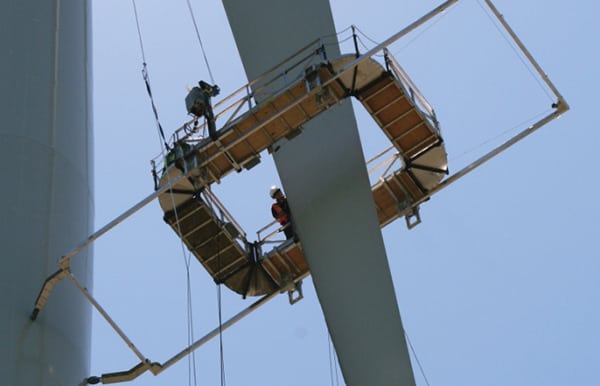Innovative Wind Turbine Blade Inspection and Maintenance Tools
The life of a wind turbine can be pretty precarious. The blades—made of laminated materials, such as composites, balsa wood, carbon fiber, and fiberglass—can reach speeds up to 180 miles per hour at the tip, which means even small particles in the air can cause damage to the surfaces. It’s probably no surprise that lightning is a serious hazard for wind turbines too.
Damaged blades are susceptible to moisture intrusion, which can quickly result in more harm as a consequence of freeze/thaw cycling. Leading edge erosion and deteriorating gel coats can also significantly decrease the lifespan of a blade and cause performance losses.
Visual inspections are an important preventive maintenance task for these valuable assets. Unearthing minor problems early allows small repairs to be made before more extensive damage results. Technicians frequently use rope access techniques to complete the inspections and perform minor repairs. For those of us who don’t particularly like heights, the thought of sailing down a wind turbine blade on ropes from the nacelle is frightening, but for the technicians who do this type of work, it’s just another day on the job.
Weather Can Be a Show Stopper
For even the most daring technician, however, there are times when the work simply can’t be done. Wind, rain, temperature, and humidity can all affect the ability to complete maintenance as scheduled. In some climates, up to 40% of all canceled wind turbine maintenance days are the direct result of adverse weather conditions.
A new maintenance habitat (Figures 1 and 2) developed by UK-based GEV Wind Power (GEV WP) may offer a solution. The company has been working with access platform provider Power Climber Wind on its initial version. The habitat attaches to blade access platforms (Figure 3) and allows users to control the environment inside of the habitat using blowers and heaters to create the optimum temperature and humidity. The apparatus could reduce time lost due to weather and possibly extend the maintenance window beyond the traditional period (May to October in the Northern Hemisphere), returning a 1% to 2% increase in annual energy production, according to GEV WP’s estimates.
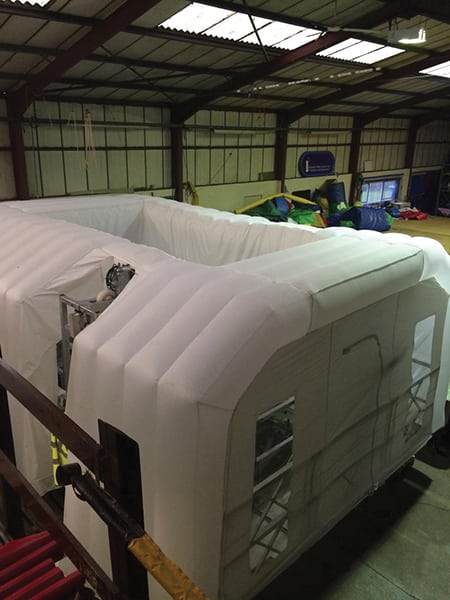 |
| 1. A maintenance cocoon. The habitat protects workers while blowers and heaters create the optimal atmosphere for repairs. Courtesy: GEV Wind Power |
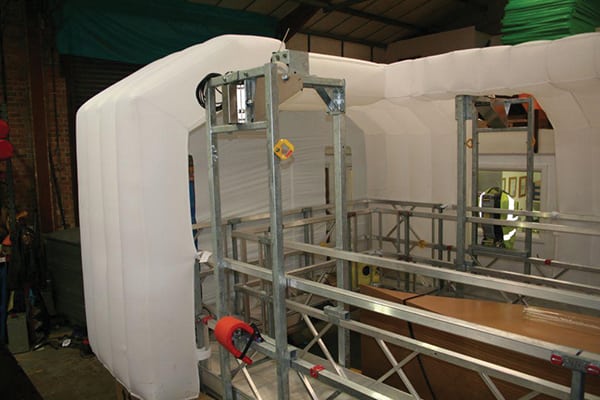 |
| 2. Weather protection. Utilizing a habitat could extend the window of opportunity for maintenance. Courtesy: GEV Wind Power |
“Habitat structures have worked well in the oil and gas sector for many years and we decided to migrate the idea across to offshore wind,” said David Fletcher, managing director of the GEV Group.
Prototype tests demonstrated the rapid deployability of the habitat. Workers were able to mount the habitat to the platform in about five minutes. Once in place, the whole structure was inflated in less than three minutes. In mid-March, GEV WP completed a successful on-blade trial of its innovative seal at the National Renewable Energy Centre blade test facility in Blyth, Northumberland, England. A short computer-animated video of the process is here: bit.ly/1BsG8F3.
Alastair Gadney, projects director for GEV WP, told POWER that, although the company doesn’t have a large number of data points yet, by using an offshore wind farm that the company maintained for a client last year, he was able to find five production days that could have been saved using the habitat. In addition, he is confident that the maintenance season could by extended by days or weeks on each end, adding more potential maintenance days to the equation. In the end, he suggested that the levelized cost of energy could be improved through the use of the habitat not only by reducing maintenance costs but also by increasing turbine availability.
Photo Scanning
While the habitat offers some significant maintenance benefits, an even better option when possible is to avoid the hands-on inspection altogether. GEV WP offers clients that option, using a panoblade inspection system created by the Paris-based company Cornis SAS.
The Cornis system uses a digital camera (Figures 4 and 5) to capture images of the entire blade surface from the ground or offshore platform deck, circumventing the need to work at heights to complete inspections. The technique is possible as the result of a unique high-resolution photographic inspection technology first developed for the space industry.
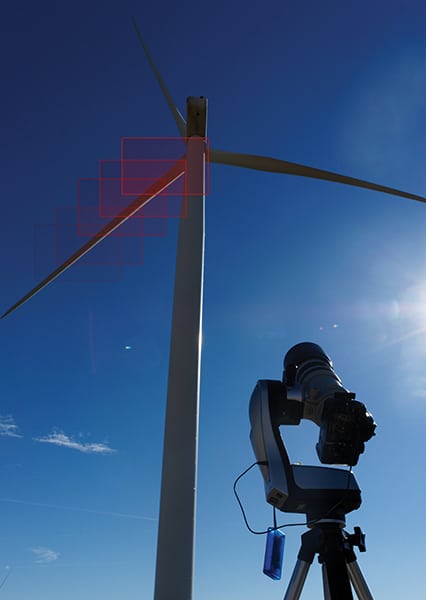 |
| 4. A picture is worth a thousand words. The entire blade surface can be scanned and stored in a central location, allowing easy tracking over time. Courtesy: Cornis SAS |
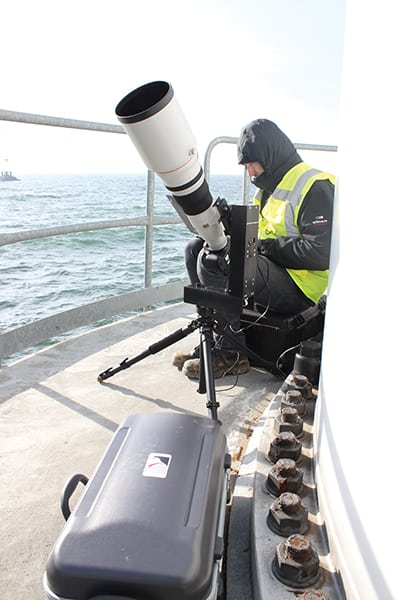 |
| 5. A permanent record. Technicians can use the Cornis blade inspection system on the ground or from offshore wind turbine maintenance platforms. Courtesy: Cornis SAS |
One of the biggest advantages of the system is the speed at which the inspection can be completed. Cornis says it can scan the two surfaces of all three blades in 1 hour for onshore turbines and 2.5 hours for offshore turbines, including transit time from one turbine to another. The company claims that the tool is very user-friendly and can be operated by most technicians after some initial training.
The camera inspections can be completed in high-wind and low-light conditions too, making it a very flexible option. Because the images are digital, they are easy to share with experts and colleagues, allowing professionals to conduct detailed evaluations of blade condition without having to visit remote turbine locations.
The inspection takes place in three steps. First, several pictures of the blades are taken with a high-powered camera on a motorized-head. Next, picture quality and repositioning is optimized using proprietary algorithms—Cornis’ computers and technical team do that work. Finally, images are examined for blade defects. When problems are spotted, comments can be added directly online by navigating over the image of the blade surface, using a web-based platform.
As previously mentioned, GEV WP offers the service to customers, but Cornis also provides a turnkey solution, handling all steps of the inspection process. For those with the inclination to do their own inspections, the panoblade equipment can be rented or purchased. A short video of the solution is here: bit.ly/1NkrS9P.
Technology at Your Fingertips
Computerized maintenance management systems have become commonplace at most traditional power plants, but the technology is still being developed for the wind power industry. GEV WP launched a tablet-based system this year called GEV Blade ERP. The company says the tool drives down operating costs by effectively capturing data, reporting, and invoicing, all in real time.
Oftentimes, Gadney said, inspection procedures require a technician to inspect a blade, take some photographs, fill out some paperwork, attach the photograph to the paperwork in some form, and send it to the wind turbine owner, so that the serial number of the blade can be recorded and the damage can be evaluated. He suggested those paper-based systems for conducting inspections are inefficient and outdated.
“You can imagine a blade technician who has been working for 8 hours or 10 hours,” Gadney postulated. “The last thing he wants to do is fill out forms.”
With the connectivity that is available at many wind farms, Gadney suggested it makes sense to tap into that technology and digitize the process, which is what GEV WP has done. With the tablet-based system, inspections can be documented quickly while the technician is still in the field, minimizing the potential for errors. ■
—Aaron Larson is a POWER associate editor.
